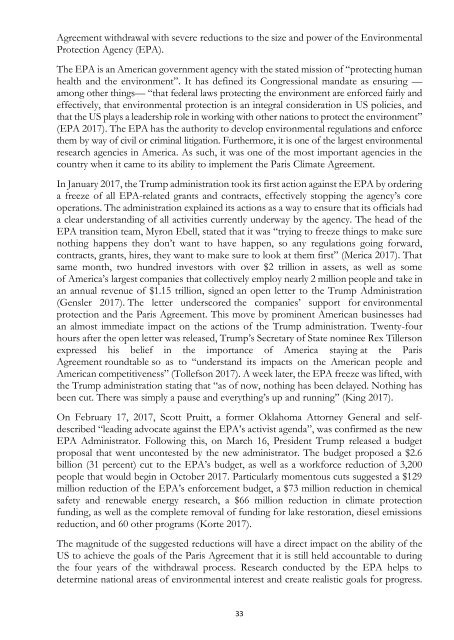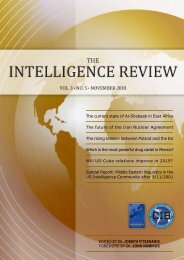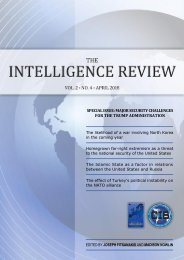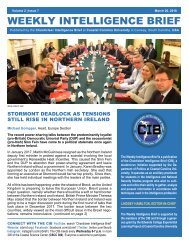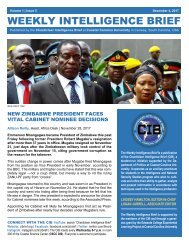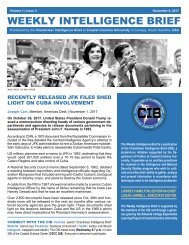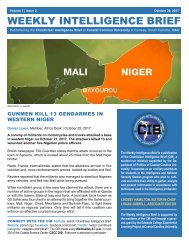The Intelligence Review | volume 2 | issue 3 |
This volume is the product of a collaboration between the European Intelligence Academy (EIA) and the Chanticleer Intelligence Brief (CIB), a student-run initiative supported by the Department of Politics at Coastal Carolina University in Conway, South Carolina, United States. Eight CIB analysts tackle some of the most pressing and timely questions confronting intelligence observers today. Topics in this volume include the current and projected strength of the Islamic State in Libya, the status of unification efforts on the island of Cyprus, the future of the government in Venezuela, and the United States’ place in the Paris climate agreement. There are also papers examining the construction of energy pipelines in Central Asia, as well as aspects of Iranian geopolitics in relation to the United States. Last, though certainly not least, we have included an estimative intelligence analysis of the first round of this year’s presidential elections in France. It refers to an event of global significance that has already taken place. However, it is included in this volume as an illustration of the power of intellectual accuracy and the ability of an intelligence analyst to achieve 100 percent accuracy —as this analyst does— by methodically considering and evaluating the analytical parameters of her question with the right balance of precision and intuition.
This volume is the product of a collaboration between the European Intelligence Academy (EIA) and the Chanticleer Intelligence Brief (CIB), a student-run initiative supported by the Department of Politics at Coastal Carolina University in Conway, South Carolina, United States. Eight CIB analysts tackle some of the most pressing and timely questions confronting intelligence observers today.
Topics in this volume include the current and projected strength of the Islamic State in Libya, the status of unification efforts on the island of Cyprus, the future of the government in Venezuela, and the United States’ place in the Paris climate agreement. There are also papers examining the construction of energy pipelines in Central Asia, as well as aspects of Iranian geopolitics in relation to the United States. Last, though certainly not least, we have included an estimative intelligence analysis of the first round of this year’s presidential elections in France. It refers to an event of global significance that has already taken place. However, it is included in this volume as an illustration of the power of intellectual accuracy and the ability of an intelligence analyst to achieve 100 percent accuracy —as this analyst does— by methodically considering and evaluating the analytical parameters of her question with the right balance of precision and intuition.
You also want an ePaper? Increase the reach of your titles
YUMPU automatically turns print PDFs into web optimized ePapers that Google loves.
Agreement withdrawal with severe reductions to the size and power of the Environmental<br />
Protection Agency (EPA).<br />
<strong>The</strong> EPA is an American government agency with the stated mission of “protecting human<br />
health and the environment”. It has defined its Congressional mandate as ensuring —<br />
among other things— “that federal laws protecting the environment are enforced fairly and<br />
effectively, that environmental protection is an integral consideration in US policies, and<br />
that the US plays a leadership role in working with other nations to protect the environment”<br />
(EPA 2017). <strong>The</strong> EPA has the authority to develop environmental regulations and enforce<br />
them by way of civil or criminal litigation. Furthermore, it is one of the largest environmental<br />
research agencies in America. As such, it was one of the most important agencies in the<br />
country when it came to its ability to implement the Paris Climate Agreement.<br />
In January 2017, the Trump administration took its first action against the EPA by ordering<br />
a freeze of all EPA-related grants and contracts, effectively stopping the agency’s core<br />
operations. <strong>The</strong> administration explained its actions as a way to ensure that its officials had<br />
a clear understanding of all activities currently underway by the agency. <strong>The</strong> head of the<br />
EPA transition team, Myron Ebell, stated that it was “trying to freeze things to make sure<br />
nothing happens they don’t want to have happen, so any regulations going forward,<br />
contracts, grants, hires, they want to make sure to look at them first” (Merica 2017). That<br />
same month, two hundred investors with over $2 trillion in assets, as well as some<br />
of America’s largest companies that collectively employ nearly 2 million people and take in<br />
an annual revenue of $1.15 trillion, signed an open letter to the Trump Administration<br />
(Gensler 2017). <strong>The</strong> letter underscored the companies’ support for environmental<br />
protection and the Paris Agreement. This move by prominent American businesses had<br />
an almost immediate impact on the actions of the Trump administration. Twenty-four<br />
hours after the open letter was released, Trump’s Secretary of State nominee Rex Tillerson<br />
expressed his belief in the importance of America staying at the Paris<br />
Agreement roundtable so as to “understand its impacts on the American people and<br />
American competitiveness” (Tollefson 2017). A week later, the EPA freeze was lifted, with<br />
the Trump administration stating that “as of now, nothing has been delayed. Nothing has<br />
been cut. <strong>The</strong>re was simply a pause and everything’s up and running” (King 2017).<br />
On February 17, 2017, Scott Pruitt, a former Oklahoma Attorney General and selfdescribed<br />
“leading advocate against the EPA’s activist agenda”, was confirmed as the new<br />
EPA Administrator. Following this, on March 16, President Trump released a budget<br />
proposal that went uncontested by the new administrator. <strong>The</strong> budget proposed a $2.6<br />
billion (31 percent) cut to the EPA’s budget, as well as a workforce reduction of 3,200<br />
people that would begin in October 2017. Particularly momentous cuts suggested a $129<br />
million reduction of the EPA’s enforcement budget, a $73 million reduction in chemical<br />
safety and renewable energy research, a $66 million reduction in climate protection<br />
funding, as well as the complete removal of funding for lake restoration, diesel emissions<br />
reduction, and 60 other programs (Korte 2017).<br />
<strong>The</strong> magnitude of the suggested reductions will have a direct impact on the ability of the<br />
US to achieve the goals of the Paris Agreement that it is still held accountable to during<br />
the four years of the withdrawal process. Research conducted by the EPA helps to<br />
determine national areas of environmental interest and create realistic goals for progress.<br />
33


